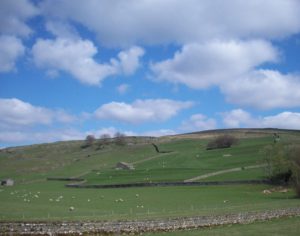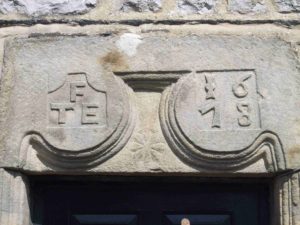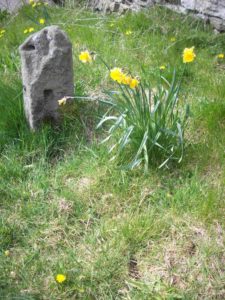A meander through a Yorkshire village obviously appealed to our members. A bakers dozen joined in the walk around this interesting dales village. We looked at many features of vernacular architecture including drip mouldings, chamfered mullions, date stones and moulded eaves. Railway houses built by the Settle Carlise railway could be seen on the East Green.
Stainforth

Field lynchets. Stainforth. C. Rousseau Jones

Stainforth Datestones C. Rosseau-Jones
Intially we started looking at the field lynchets on both sides of the main road. Next we saw the Raines Barn and cottage at the edge of the village. Like many Yorkshire villages Stainforth has a mix of housing built over four centuries. Prominent houses built in the 19th century stand cheek by jowl with earlier 17th and 18th centuries buildings.
However, not only humans need shelter and bee boles could be seen across the village. These are alcoves built into walls to acomodate a skep, an early form of beehive. The remains of the stocks, the sites of the two now sadly defunct schools, a ladies walk, stepping stones, coach houses and an artist studio. A slaughter house, hennery piggery, village institute, old village fountain, the sites of old mills, dye houses and a tenter field. Nearby was the old village corn mill. However, the list goes on but the old packhorse bridge led us to the Craven Heifer, formerly the Pack Horse Inn. Regrettably, we had too little time for a beer!
Knight Stainforth
After lunch we completed the tour and visited Knight Stainforth. Stainforth is split into two parishes. Stainforth and Little Stainforth or Knight Stainforth, are accessed over an attractive single track bridge. Built in 1672, the Hall and cottage here were yet more interesting buildings!

What’s left of the stocks at Stainforth. C. Rousseau Jones
Notable people connected to the villages are Roger de Poitou, who held the land but never visited. Later, when his land was forfeited it came into the hands of the de Percy’s and thence to Sawley Abbey. The Tempest and Darcy families also lived there. Sir Richard Tempest b. 1425 fought in the Wars of the Roses. A later Richard Tempest was buried in Giggleswick church alongside his two wives and the head of his horse! Samuel Watson an apparently notable and intransigent local figure became a Quaker and the Hall became licensed as a Quaker Meeting House. The Hall appears to have been in the hands of the Maudsley family for around 170 years now. One Henry Maudsley helped to start and fund the world renowned Maudsley Hospital in London at the beginning of the 20th century.
We received a warm welcome from some of the residents of the village but the area is well worth another visit. Without time to visit the Hofmann Kiln at Langcliffe or Victoria Cave we did find time for the usual tea and cream scones before we we wended our way home!
Did you know?
The Maudsley Hospital has had a pick axe on its coat of arms since 1985 – a nod to the symbol that is on the Maudsley coat of arms at the Hall at Knight Stainforth.
Why not join us on a future event? We’re a friendly bunch!